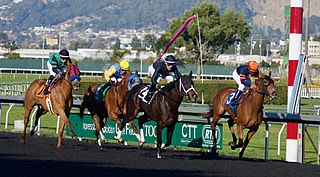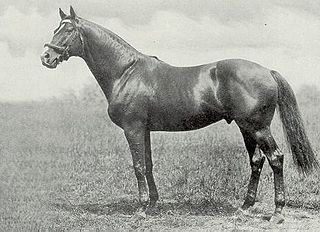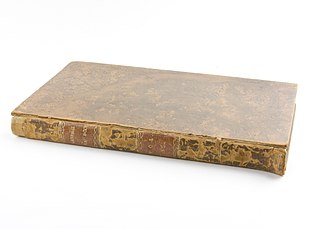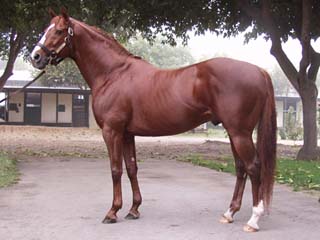
The American Quarter Horse, or Quarter Horse, is an American breed of horse that excels at sprinting short distances. Its name is derived from its ability to outrun other horse breeds in races of a quarter mile or less; some have been clocked at speeds up to 44 mph (70.8 km/h). The development of the Quarter Horse traces to the 1600s.

Thoroughbred racing is a sport and industry involving the racing of Thoroughbred horses. It is governed by different national bodies. There are two forms of the sport – flat racing and jump racing, the latter known as National Hunt racing in the UK and steeplechasing in the US. Jump racing can be further divided into hurdling and steeplechasing.

Horse racing is an equestrian performance sport, typically involving two or more horses ridden by jockeys over a set distance for competition. It is one of the most ancient of all sports, as its basic premise – to identify which of two or more horses is the fastest over a set course or distance – has been mostly unchanged since at least classical antiquity.

Saratoga Race Course is a Thoroughbred horse racing track located on Union Avenue in Saratoga Springs, New York, United States. Opened in 1863, it is often considered to be the oldest major sporting venue of any kind in the country, but is actually the fourth oldest racetrack in the U.S.. In 1857 the Empire Race Course was opened on an island in the Hudson River near Albany, but was in operation only a short time.
The Polo Park Racetrack was a Canadian horse racing facility in Winnipeg, Manitoba. Considered one of the finest racetracks in Western Canada, it was built by Canadian Horse Racing Hall of Fame inductee R. James Speers. The six-furlong track opened in 1925 under the charter of the Winnipeg Jockey Club and the charter of St. Vital Agricultural Society in Winnipeg, Manitoba. At the same time, James Speers founded the Prairie Thoroughbred Breeders' Association to promote a breeding industry in Western Canada. In 1930 he created the Canadian Derby, a premier race for Canadian-bred three-year-old Thoroughbreds hosted by Polo Park Racetrack until its closure in 1956.
The Toboggan Stakes, formerly the Toboggan Handicap, is an American Thoroughbred horse race run annually during the first week of March at Aqueduct Race Track in Queens, New York. Open to horses aged three and older, the Grade III event is contested over at a distance of six furlongs on the dirt and offers a purse of $150,000 added.
Hastings was an American Thoroughbred racehorse and stallion.
John Milton Gaver Sr. was an American Hall of Fame Thoroughbred racehorse trainer.

Hurry On was an undefeated British Thoroughbred racehorse and sire that revived the Matchem sire line. English trainer Fred Darling called Hurry On the best horse he ever trained.

Morris Park Racecourse was an American thoroughbred horse racing facility from 1889 to 1904. It was located in a part of Westchester County, New York that was annexed into the Bronx in 1895 and later developed as the neighborhood of Morris Park. The racecourse was the site of the Belmont Stakes from 1890 through 1904 as well as the Preakness Stakes in 1890.

Thoroughbred breeding theories are used by horse breeders in an attempt to arrange matings that produce progeny successful in horse racing. Bloodstock experts also rely on these theories when purchasing young horses or breeding stock. A basic understanding of these theories can also help the racing public understand a horse's theoretical genetic potential. The breeding theories stem from the belief that careful analysis of bloodlines can lend predictability to breeding outcomes. A well-designed mating increases the probability of the offspring's success, although many other factors also come into play.

Omar Khayyam (1914–1938) was a British-born Thoroughbred racehorse who was sold as a yearling to an American racing partnership and who became the first foreign-bred horse to win the Kentucky Derby. He was named for the famous Persian mathematician, poet, and astronomer, Omar Khayyam.

The Thoroughbred is a horse breed developed for horse racing. Although the word thoroughbred is sometimes used to refer to any breed of purebred horse, it technically refers only to the Thoroughbred breed. Thoroughbreds are considered "hot-blooded" horses that are known for their agility, speed, and spirit.

Robert Livingston Gerry Sr. was an American businessman and owner of thoroughbred racehorses.

Chance Play was an American Champion Thoroughbred racehorse and Champion sire. In a career which lasted from 1925 to 1928 he ran in thirty-nine races and won sixteen of them. Although he was successful in his early career over sprint distances, he did not reach his peak until the age of four in 1927, when he was arguably the best horse in the United States, winning several major races including the two-mile Jockey Club Gold Cup.
Hilton Alexander Dabson was an American Thoroughbred horse racing jockey and racehorse trainer. In 1933, he was the leading rider at Rockingham Park.
Old England (1899–1908) was an American Thoroughbred racehorse best known for winning the 1902 Preakness Stakes. Owned and trained by Green B. Morris, he was sired by Goldfinch. Old England was out of the mare Queen Bess, a daughter of Marden.
Challenge Stakes may refer to one of several horse races:

A handicap race in horse racing is a race in which horses carry different weights, allocated by the handicapper. A better horse will carry a heavier weight, to give it a disadvantage when racing against slower horses.
Toboggan was a British Thoroughbred racehorse and broodmare. She showed very promising form as a juvenile in 1928 when she won three of her four races including the Dewhurst Stakes. In the following year she finished third in the 1000 Guineas and went on to win the Epsom Oaks, Coronation Stakes and Jockey Club Stakes. She had some success as a broodmare producing the top-class winner Bobsleigh and Hydroplane, the dam of Citation.
This page is based on this
Wikipedia article Text is available under the
CC BY-SA 4.0 license; additional terms may apply.
Images, videos and audio are available under their respective licenses.











